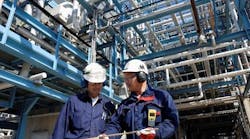Isauro Martinez-Cairo, director of asset performance at Invensys Operations Management, fields questions from Flow Control magazine on trends in asset management for fluid handling applications.
Q: From your perspective, what are the key technology trends of the past 10-20 years in the area of asset management systems for fluid handling applications? How has asset management technology evolved to better meet the application needs of end-users?
A: In the last decade, sensors and actuators have become microprocessor-based. Standards to communicate with these assets via fieldbus protocols have developed. Hence, Instrument Asset Management (IAM), which addresses lifecycle management of smart sensors and actuators, including the machinery controlled by the smart actuator, has become a hot area for plant investment.
Q: In your interactions with end-users, what are some of the common asset management-related application issues you regularly encounter when it comes to fluid handling applications? Are there any common areas of concern end-users are currently experiencing when it comes to asset management in general?
A: Based on our research, business drivers for fluid handling applications fall into four main areas:
- Workforce enablement, including knowledge transfer, managing the aging workforce, workforce effectiveness, and actionable business intelligence;
- Improved profitability, including improving uptime and availability, energy monitoring and reduction, extending asset life and cost control for labor and parts;
- Safety and risk management, including maintaining a safe work environment and risk-based asset management; and
- Corporate social responsibility, including carbon footprint and emissions control and ensuring regulatory compliance.?
Q: What are some of the core technologies/capabilities end-users should be considering today when specifying an asset management system?
A: Condition monitoring, management, and predictive capabilities can turn huge volumes of production data into actionable asset intelligence in real-time, enabling informed decision-making at every level of the production enterprise. Key benefits include increased operational safety, optimized costs of maintenance, improved sustainability of operations, lower energy consumption, and reduced variance in the response of the maintenance personnel.
Q: In your experience, what are some common pitfalls end-users should be aware of when designing and/or scaling up an asset management system? Are there any mistakes that you see end-users making on a regular basis regarding the design and/or scaling up of asset management systems?
A: The biggest pitfalls we have seen are inadequate investment in business process definition, which among other things raises transactional costs. Setting expectations that exceed the niche expertise available in the plant can also be a problem. The solution to all of this begins with the process definition.
Q: What about wireless? What role do you see wireless playing in the area of asset management now and going forward? What do you see, if anything, as the key obstacles for wireless to overcome in terms of widespread adoption for industrial asset management?
A: Mobility is a key component of a complete solution for connecting all of your wired and stranded assets, enabling broad visibility into the performance of your assets. This asset-centric approach to wireless makes tracking asset performance straightforward.
Key benefits of wireless include improved operational discipline and reliability, improved safety and compliance, increased workforce productivity, higher asset availability, and improved process visibility.
Key obstacles to wireless include implementation in hazardous environments, cost of deployment, and interference from other devices competing for limited spectrum, and multiple standards.
Q: How do application requirements impact asset management needs?
A: Automated asset management is most successful when implemented as part of a strategic plan that maps to the highest-level business drivers of the plant, such that asset availability and utilization, are optimized in concert with the overall business performance of the plant.
Q: In terms of new capability and/or technologies, what can end-users look forward to in the area of asset management for fluid handling systems going forward? How will the asset management technologies of tomorrow be better than those of today?
A: End-users can look forward to improvements in performance analysis, enterprise workflow management and asset optimization.
Performance analysis is an effort to capture knowledge, rules, best practices, and providing intuitive tools that enable visualization and discovery of actionable information and intelligence in real-time by exploiting performance, operational, and transactional data of the enterprise.
Enterprise workflow provides the ability to create enterprise and horizontal workflow solutions to address business challenges. This enables customers to improve business performance, and reduce costs within and across functional business units, while maximizing their investments in current and future IT infrastructure.
Asset optimization is a consultative effort to provide solutions for simulation and forecasting asset effectiveness, asset lifecycle, utilization and replacement, taking into consideration financial and real-time data used in opportunity cost analysis. Providing the economic picture is an aid to better decision making.
iom.invensys.com
